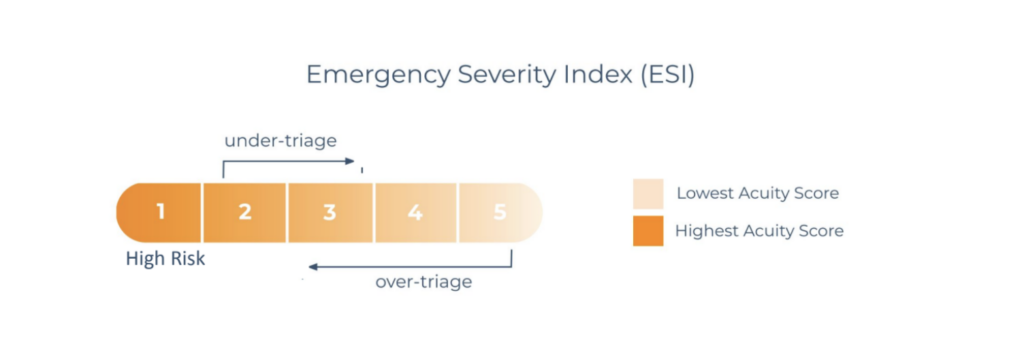Each day in emergency departments (EDs) across the United States, nurses prevent devastating outcomes as lives hang in the balance. If you’ve ever spent time in the ED in any capacity, it’s clear that ED nurses are the department’s backbone, driving patient outcomes, while maintaining calm and order, constantly leveraging their critical thinking skills and training to improve patient outcomes in healthcare settings.
Underneath these extraordinary skills, nurses are still human. They are subject to mental and physical fatigue and often tasked with more than one highly trained individual can handle.
This is where KATE AI comes in. A technology born from listening to nurses’ needs and real-world experiences in the ED, designed to validate their critical insights and reduce the excessive risk and workloads they bear that can contribute to nurse burnout and job strain.
Unfortunately, this risk was not hypothetical for KATE’s co-founder and Mednition CEO, Steven Reilly, who developed KATE from personal experience witnessing medical errors that impacted the life of his own daughter, its namesake. At that time, he observed that examples of AI in healthcare were limited. “It’s unacceptable in today’s day and age that clinicians don’t have support which is readily available in other industries, which could be developed for them to help care for a patient who’s come to them in their most dire need,” he says. KATE’s mission is to save lives and help establish a gold standard for care.
Understanding Unique Challenges In Professional Nursing
To set the stage, imagine, at any given moment, how an ED nurse can unexpectedly face a split-second decision that can forever alter the course of a life. Patients who present as seemingly stable with minimal symptoms can suddenly deteriorate in an instant. Each patient who passes through ED triage can potentially signal the need for a rapid re-prioritization of ED resources, often without warning.
Nursing decisions need to be made countless times daily, and there is no room for error. The layers of impact from one decision are complex in nursing care.
Should the nurse move a triage patient back to an ED bed, even though objective data says no, but their gut says yes? If they misassign the patient’s acuity level, did they just redirect attention away from a more critical patient? These are difficult everyday situations that not only require expert training and experience but also objective support from nursing management. “We’re asking nurses to do more with less, and it’s taking a toll on their mental and physical health,” notes Mednition’s Chief Nursing Officer, Deena Brecher, MSN, RN, ACNS-BC, CEN, CPEN, FAEN.
It’s clear to see how these unique pressures and working conditions inside the ED are real, with a harsh and challenging reality that doing more and more with less support can lead to critical and life-altering outcomes for nursing staff and patients’ lives in the balance.

The Challenge of Being Heard In the Nursing Profession
In the context of these responsibilities and the ED environment, it’s critical to physically and psychologically empower nurses’ voices so they can effectively deliver patient care. It’s easy for operational demands to stay top-of-mind for ED and nursing leadership and for nursing voices to be recognized in theory but not as often in practice. “The world of nursing management is very different than the world of bedside nursing. And all too often, people don’t understand bedside,” explains Brecher.
Behind the scenes, nursing leaders must balance competing priorities. They must consider not only structural empowerment but also operational efficiencies, resource constraints, throughput, documentation quality, appropriate coding for services, and patient safety. These factors impact reimbursement, hospital operating margins, and critical health system quality ratings. All vital aspects of an efficient emergency care department alongside the underlying duty to save lives.
Literature supports the idea that nursing advocacy is an essential part of patient safety and quality care. Nursing empowerment bridges the gap between operational demands and nursing voices, reducing nursing burnout, improving retention, and repairing nurse staffing shortages. It also impacts patient outcomes, reduces health inequity, and positively influences important measures such as emergency department overcrowding, length of stay (LOS), and the rate of patients who have “left without being seen” (LWBS).
Empowering nurses, according to Brecher, “Really means having the tools and resources to be successful. And it’s not just about the piece of equipment. It’s about nursing education and how to use the equipment. It’s about having access to a resource.” Without it, the emotional and mental impact on these nurses’ well-being can become increasingly heavy and unbearable.
AI Advocacy: KATE AI’s Role in Empowering Nurses and Healthcare Professionals
KATE AI stands in this space between operational demands and nursing voices and is an essential healthcare technology resource to empower nurses with improved clinical decision-making and problem-solving capabilities. It’s important to note that KATE is a nurse-AI collaborative effort. As AI has gained ground, a common concern is that it will replace existing talent rather than enhance it. But, as Brecher emphasizes, AI has benefits in healthcare, and “KATE AI should be seen as a tool to empower nurses, not replace them.”
This empowerment is keenly felt by the healthcare professionals who work with KATE in clinical practice. “KATE allows you to think outside the box and notice things that you might not have noticed with just the general data you input,” explains one ED nurse. “After using it for two years, I think most of us have adapted positively to how it’s helped us and our patients.” The importance of the twofold ripple effect, not only helping to provide an accurate baseline assessment but drastically increasing the daily work-life balance and satisfaction of nurses.
Closing the Feedback Loop: Impact on Work Environments and Professional Development
How does KATE AI accomplish this? KATE relies on data science and machine learning to convert the wealth of data it collects that is mapped to ED best practices and evidence into high-quality ESI Acuity assessments and Sepsis risk detection.
KATE’s predictive AI means that rather than operating as a generative AI (where inputs are modified to create new content), KATE leverages real-world data points from nurses’ patient interactions and returns highly accurate predictions to support a nurse’s final clinical judgment. Whereas generative AI can produce convincing results that are inaccurate (hallucinations), KATE AI only uses clinically validated data to support nurses.
“Our models are designed to do very specific clinical functions, and we have millions of records that we train on and test on. We know that when we build a new model, if a single patient prediction has changed, we can analyze and understand why. You can’t do that with a large language model. There is no prediction transparency, so you don’t know what you’ll get,” explains Mednition President and Co-Founder Christian Reilly.
KATE’s highly validated AI also integrates and harnesses nurse feedback to improve KATE and patient care over time. KATE Analytics allows ED Educators to drive actionable plans helping ED leadership to improve their EDs and triage processes.
“Every AI team should have a positive user feedback loop,” states Reilly. “We’ve always had one in our product.” Using this feedback, nurses can note predictions they agree or disagree with and highlight instances where KATE successfully notified a nurse of a critical patient they may have otherwise missed. “We look at those, and that’s another feedback loop in continuous quality improvement of our AI models,” says Reilly. Unlike generative AI models, KATE predictions are strict probability calculations based on real-world data and are not prone to random hallucinations. Clinically validated training data helps ensure each nurse is empowered to give their patients the right care for their clinical presentation.

Translating Healthcare Data into Action
KATE Triage was initially developed using data from 166,175 patients, with the result being that KATE’s Emergency Severity Index (ESI) acuity accuracy was 26.9% higher than the average triage nurse accuracy and 93.2% higher than triage nurses at accurately categorizing patients on the boundary of levels 2 and 3, with ESI level predicting risk of decompensation. KATE’s underlying ability to translate data into action, again, not only helps more precisely categorize and deliver care but also gives nurses the validated support to make confident decisions under immense pressure. Since the original 2021 study, KATE has evolved and now trains on a much larger dataset and is updated quarterly with clinical quality improvements.
KATE’s Decision Support: Psychological Empowerment
It cannot be emphasized enough that, in the fast-paced ED, initiatives that reduce nurses’ cognitive burden and help support job satisfaction and mental health have many positive downstream benefits. KATE AI does just that, providing clinical decision support that substantially reduces the mental strain associated with nurses’ jobs.
What is clinical decision support as it relates to AI? Increasing patient complexity, coupled with varying levels of nursing experience, can overlap to increase the risk of ED patients being negatively impacted by a preventable error. This makes artificial intelligence in clinical decision support and triage tools even more valuable. KATE AI helps nurses validate their clinical suspicions efficiently, leading to more confident care delivery.
This efficient and proactive evaluation with the help of KATE AI is easily apparent when looking at how KATE can improve the identification of complex and life-threatening conditions. Registered nurse and ED Supervisor at Adventist Health White Memorial, Evelyn Miguel, MSN, RN, shares, “I think that a healthcare organization that is investing in something like KATE means that the organization is invested in the education for their staff as well as investment into their patients.” Here, as a nurse-first organization focused on saving lives and improving quality of care, no better tool bridges this gap.
Bridging the Gap: KATE AI and Executive Leadership
KATE’s ability to bring nurse feedback to the forefront of real-world practice also supports executive leadership in improving their clinical workflows, impacting financial as well as patient outcomes. KATE provides:
- Real-time dashboards for measuring clinical performance at ED Triage
- Aggregation analysis of patient chief complaint vs. disposition and diagnosis
- Nurse recognition of high-risk patients
- A collection of cohorts from a hospital’s patient population in seconds, with a comparison of these cohorts across thousands of clinical dimensions
- A clinical Natural Language Processing (C-NLP) that understands the full free text of nursing notes for building cohorts for Education, QI projects, or compliance reporting
“KATE supports standardization of triage acuity assignment, providing critical information to our leadership team to identify improvement areas which we can now actively address,” shares Donovan Stewart, MSN, RN, CEN, MICN, Patient Care Executive. Where alternative methods for collecting these insights can cost organizations vast amounts of time and money, KATE is bringing these to the forefront of executive fingertips now and in the future.
Advocating for AI: A Call to Nursing Leadership
It goes without saying that executive leaders must consider the organizational commitment and cost of implementing AI in healthcare and weigh that against the benefits. Luckily, the equation is simple. KATE AI improves nurses’ critical thinking, ED wait times, patient satisfaction, nursing documentation, and reimbursement, ultimately creating an ROI of tenfold-plus.
KATE AI is the equivalent of having “The most experienced nurse sitting on every one of your triage nurses’ shoulders 24/7. KATE will support your ED leadership with insight and action, helping them understand everything that’s going on at your front door and across an entire health system,” notes Steven Reilly. “And then, rolling that up highlighting successes and opportunities that we need to be working on to improve outcomes and equitably serve those in our community.”
This combination of nurse empowerment and support, amplifying nursing voices within the ED to reduce nursing burnout and improve patient outcomes and financial returns, makes KATE AI a unique and innovative tool for any healthcare organization that implements it.
If you’re ready to learn more about KATE AI’s capabilities and hear real testimonials from other leaders who have seen its benefits in nursing work, contact Mednition today. We’ll provide the resources you need to start a conversation with your organization about using KATE AI to deliver data-driven, innovative healthcare in your nursing practice.
